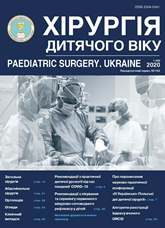Organ-preserving principles of reconstructive surgery for type iv intestinal atresia in newborns
DOI:
https://doi.org/10.15574/PS.2020.66.21Keywords:
multiple intestinal atresia, longitudinal tapering enteroplasty, surgical treatment, infantAbstract
Small intestinal atresia is the most common cause of congenital intestinal obstruction in newborn children. Due to the development of neonatal surgery survival of patients with this pathology has improved significantly, especially with type I–IIIa atresia, however, surgical treatment of type IIIb–IV atresia remains a complex problem. First of all, it is laparotomy, resection and multiple anastomosing of obstructed small intestinal segments with Mikulich enterostomy. The postoperative course was complicated by the development of bacterial and fungal sepsis. In the inter-operative period, complete parenteral nutrition and mucous fistula refeeding were performed to maintain continuity of gastrointestinal passage. On the 36th day of life, the second stage of surgical management was performed: relaparotomy, viscerolysis with subhepatic abscess repair, longitudinal tapering enteroplasty with enteroenterostomy. Preservation of the total small intestinal length up to 50.0 cm was achieved by applying a combination of proximal longitudinal tapering enteroplasty and distal multiple anastomosing. The baby achieved enteral autonomy at the age of 10 months.Conclusions. Prevention of short bowel syndrome in infants with type IV intestinal atresia consists in adherence to organ-preserving principles of surgical treatment. To preserve the length of the small intestine, the most useful is the combination of techniques of appropriate proximal intestinal segment enteroplasty and distal multiple gut anastomosing.
The research was carried out in accordance with the principles of the Helsinki Declaration. The study protocol was approved by the Local Ethics Committee of an participating institution. The informed consent of the child’s parents was obtained from the studies.
No conflict of interest was declared by the authors.
References
Alexander F, Babak D, Goske M. (2002, Nov). Use of intraluminal stents in multiple intestinal atresia. J Pediatr Surg.37(11): E34. https://doi.org/10.1053/jpsu.2002.36206; PMid:12407564
Bishay M, Pichler J, Horn V, Macdonald S et al. (2012, Feb). Intestinal failure-associated liver disease in surgical infants requiring long-term parenteral nutrition. J Pediatr Surg.47(2): 359-62. https://doi.org/10.1016/j.jpedsurg.2011.11.032; PMid:22325390
Dao DT, Demehri FR, Barnewolt CE, Buchmiller TL. (2019, Jun). A new variant of type III jejunoileal atresia. J Pediatr Surg. 54(6):1257-1260. https://doi.org/10.1016/j.jpedsurg.2019.02.003; PMid:30827488 PMCid:PMC6545255
Elliott T, Walton JM. (2019 Feb 5). Safety of mucous fistula refeeding in neonates with functional short bowel syndrome: A retrospective review. J Pediatr Surg. pii: S0022-3468(19)30087-9. https://doi.org/10.1016/j.jpedsurg.2019.01.050; PMid:30786992
Federici S, Domenichelli V, Antonellini C, Domini R. (2003, Aug). Multiple intestinal atresia with apple peel syndrome: successful treatment by five end-to-end anastomoses, jejunostomy, and transanastomotic silicone stent. J Pediatr Surg.38(8): 1250-2. https://doi.org/10.1016/S0022-3468(03)00281-1
Gonzalez-Hernandez J, Prajapati P, Ogola G, Channabasappa N et al. (2017 May). Predicting time to full enteral nutrition in children after significant bowel resection. J Pediatr Surg.52(5): 764-767. https://doi.org/10.1016/j.jpedsurg.2017.01.038; PMid:28168985
Hukkinen M, Kivisaari R, Koivusalo A et al. (2017). Risk factors and outcomes of tapering surgery for small intestinal dilatation in pediatric short bowel syndrome. J Pediatr Surg.52(7): 1121-27. https://doi.org/10.1016/j.jpedsurg.2017.01.052; PMid:28185632
Louw JH, Barnard CN. (1955). Congenital intestinal atresia: Observation on its origin. Lancet.269: 490-7.
Peng Y, Zheng H, He Q, Wang Z et al. (2018, Oct). Is the Bishop-Koop procedure useful in severe jejunoileal atresia? J Pediatr Surg.53(10): 1914-1917. https://doi.org/10.1016/j.jpedsurg.2018.03.027; PMid:29709288
Romao RL, Ozgediz D, de Silva N, Chiu P et al. (2011, Jul). Preserving bowel length with a transluminal stent in neonates with multiple intestinal anastomoses: a case series and review of the literature. J Pediatr Surg.46(7): 1368-72. https://doi.org/10.1016/j.jpedsurg.2011.01.011; PMid:21763836
Stollman TH, de Blaauw I, Wijnen MH, van der Staak FH et al. (2009, Jan). Decreased mortality but increased morbidity in neonates with jejunoileal atresia; a study of 114 cases over a 34-year period. J Pediatr Surg.44(1): 217-21. https://doi.org/10.1016/j.jpedsurg.2008.10.043; PMid:19159746
Wales PW, Dutta S. (2005, Mar). Serial transverse enteroplasty as primary therapy for neonates with proximal jejunal atresia. J Pediatr Surg.40(3): E31-4. https://doi.org/10.1016/j.jpedsurg.2004.11.005; PMid:15793710
Wang J, Du L, Cai W et al. (2014). Prolonged feeding difficulties after surgical correction of intestinal atresia: a 13-year experience. J Pediatr Surg.49: 1593-7. https://doi.org/10.1016/j.jpedsurg.2014.06.010; PMid:25475800
Weber DM, Freeman NV. (1999, Sep). Duodenojejunal atresia with apple peel configuration of the ileum and absent superior mesenteric artery: observations on pathogenesis. J Pediatr Surg.34(9): 1427-9. https://doi.org/10.1016/S0022-3468(99)90029-5
Downloads
Published
Issue
Section
License
The policy of the Journal “PAEDIATRIC SURGERY. UKRAINE” is compatible with the vast majority of funders' of open access and self-archiving policies. The journal provides immediate open access route being convinced that everyone – not only scientists - can benefit from research results, and publishes articles exclusively under open access distribution, with a Creative Commons Attribution-Noncommercial 4.0 international license(СС BY-NC).
Authors transfer the copyright to the Journal “PAEDIATRIC SURGERY.UKRAINE” when the manuscript is accepted for publication. Authors declare that this manuscript has not been published nor is under simultaneous consideration for publication elsewhere. After publication, the articles become freely available on-line to the public.
Readers have the right to use, distribute, and reproduce articles in any medium, provided the articles and the journal are properly cited.
The use of published materials for commercial purposes is strongly prohibited.

